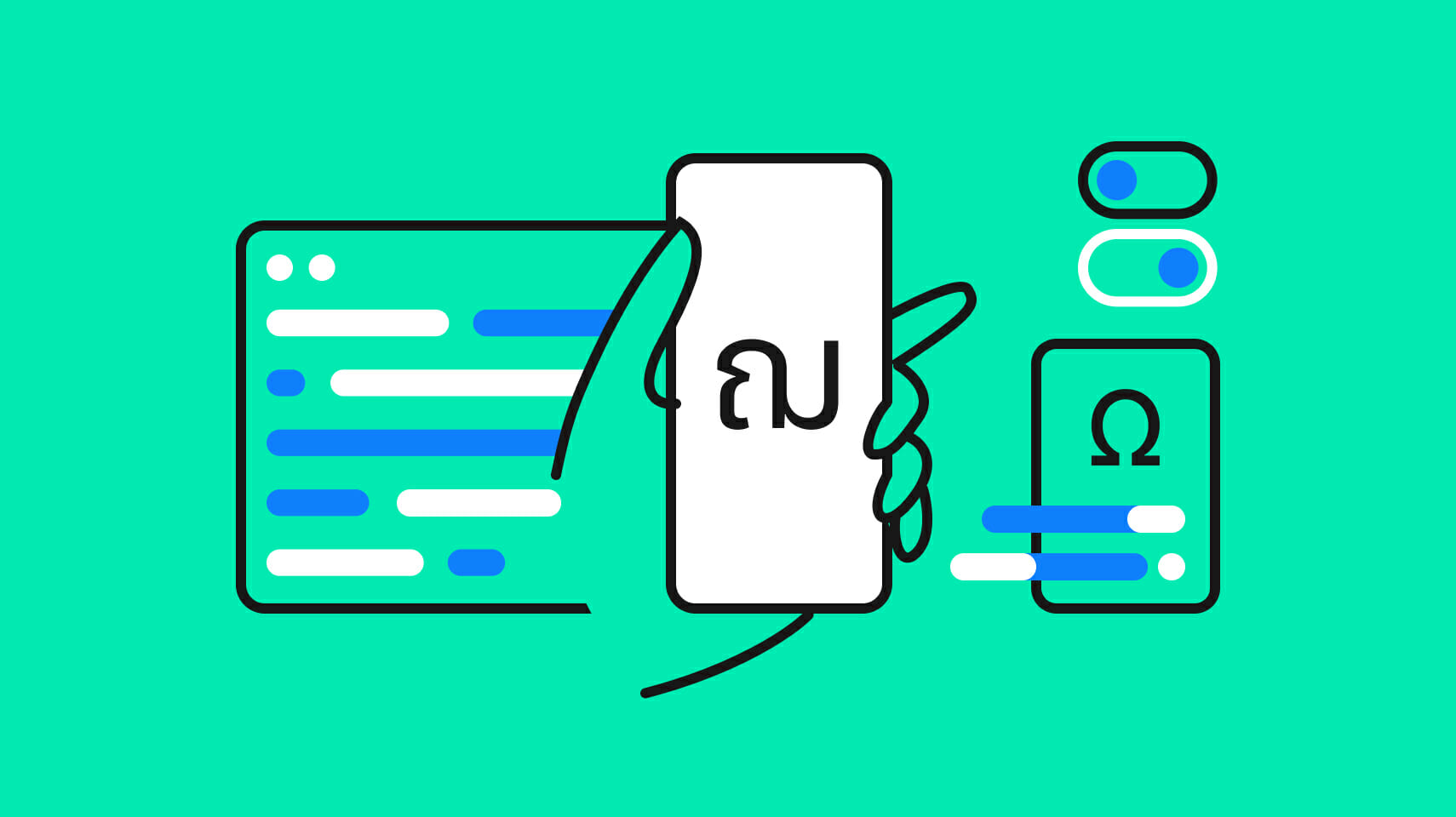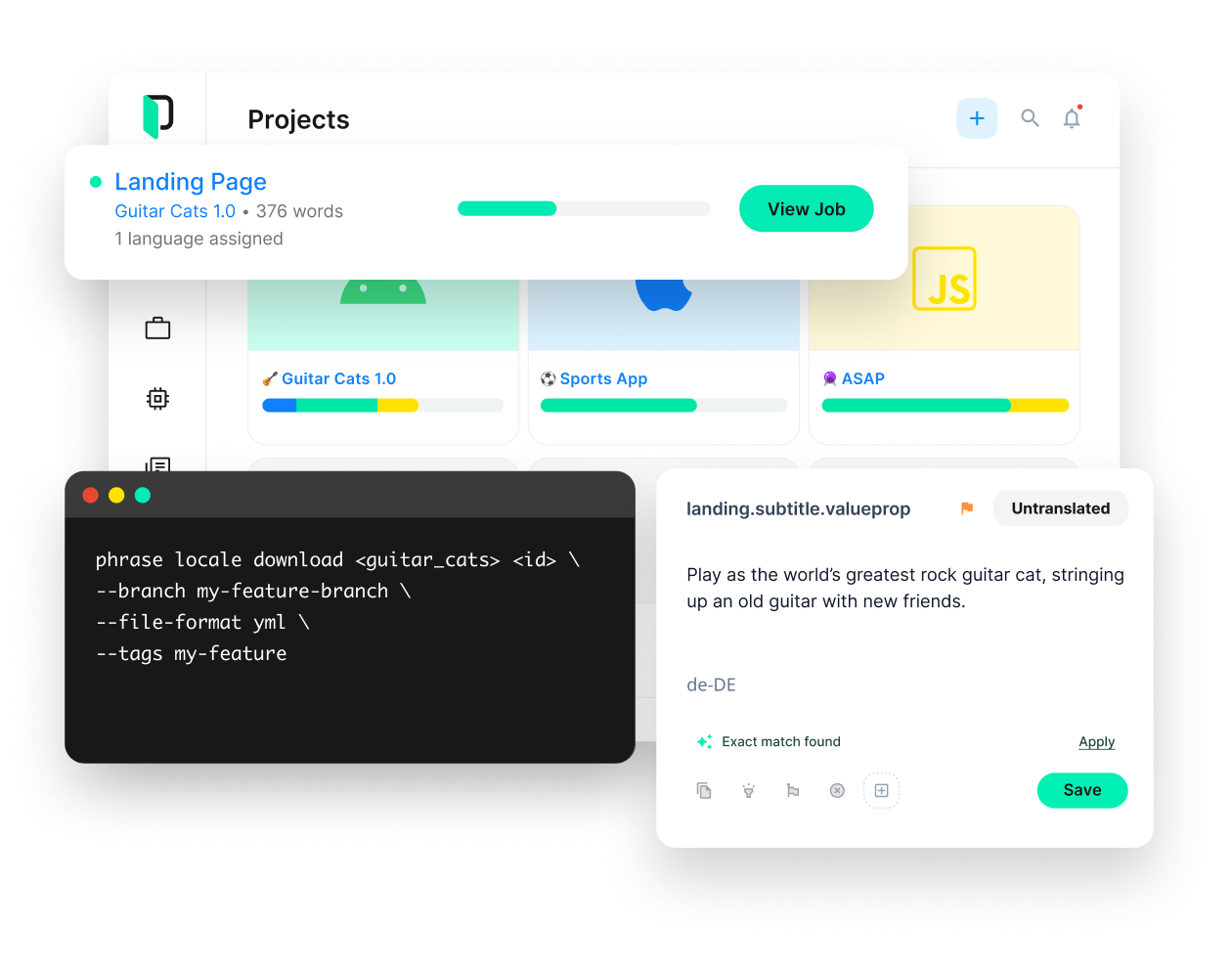Localization strategy
The Future of Software is Global: How Software Translation Can Help

Software is like the new superhero of the modern world—it’s everywhere, it does amazing things, and it’s always saving the day. Consumers from every corner of the world interact with software daily in their homes, in their workplaces, and on their phones. The way they do it, though, depends largely on their culture and native language—and this is where software translation comes in.
Software translation is crucial in increasing the usability of a product: It helps make it accessible to users worldwide in their native language. The more a product responds to cultural needs, the more likely it is to attract local users and become popular. In this guide, we’ll cover everything about software translation and how to approach it as a lever for sustainable global growth.

Phrase Strings
Take your web or mobile app global without any hassle
Adapt your software, website, or video game for global audiences with the leanest and most realiable software localization platform.
What is software translation?
Software translation is just one part of the overall process of localizing a product—that is, making it available to users worldwide in their native language, cultural context, and market environment.
In a nutshell, software translation is a largely linguistic process. It involves converting the text used in a piece of software into another language. The goal is to allow users worldwide to understand and interact with a web or mobile app in their native language.
The adaptation of everything else about a software application—including its layout, design, images, and UX—falls within a discipline known as software localization. While some people use them interchangeably, translation and localization aren’t the same: Translation is part of localization, but localization goes beyond translation to include all the cultural and market-driven adaptations of a product.
Why is software translation important?
Imagine that a glitch in your phone made everything suddenly appear in a foreign language that you don’t understand. Maybe you’d be able to work out some words here and there, but you’d be completely lost in the interface. It would feel like being cast away in a strange land.
The translation of software products is important because it helps users everywhere interact with web or mobile apps seamlessly and comfortably—in their native language. It’s like creating a bridge of understanding between people who can’t communicate with words but can still share the same experience.
The business benefits of software translation
For businesses, software translation isn’t just a nicety—it’s an opportunity. By offering a product in different languages, businesses can position themselves to conquer new markets and gain access to new customer bases.
The main benefits of software translation include:
- Wider global market reach: With the help of software translation, businesses can target new markets, develop a stronger presence in them, and capture a larger portion of the global market share.
- Increased user engagement: Because software translation has a direct impact on user experience, it can drive more engagement from local customers.
- Improved customer satisfaction: Users appreciate apps that are available in their native language because they feel seen, understood, and valued. This leads to higher levels of customer satisfaction.
- Enhanced brand reputation: In connection with the above, translating software into different languages can help a business establish a positive brand reputation—after all, people remember brands that make them feel heard and respected.
- Cost savings: When you translate your software, you avoid the need to develop separate applications for different countries from scratch, thus streamlining the development process and saving money in the long run.
How do you translate software?
However powerful software translation is in helping businesses meet the needs of their global customers, it isn’t as easy as flipping a switch.
Preparing the stage: software internationalization
It’s important to remember that software translation falls under the umbrella of a greater process—software localization—that fits into the company’s broader globalization strategy.
Before any translation work can start, your developers need to make the product localizable, i.e. ensure it can be easily adapted and translated to different markets and languages without significant changes to the code. This is called software internationalization.
Translating software step by step
Once your software product is localizable, the actual translation process begins. Let’s have a look at the key steps to making the most of software translation:
Step #1: Define goals and objectives
Having an understanding of what you want to accomplish with your software translation will help you set achievable goals and measure progress.
Step #2: Establish a budget
On top of time and effort investments and careful consideration of resources, software translation involves financial costs. Having a budget in place will help you plan the process accordingly.
Step #3: Identify your target market and audience
Before you can start your software translation, you need to identify the target market. That requires comprehensive research into markets and cultures—and an understanding of how these will impact translation efforts.
Step #4: Choose the target language(s)
Once you have identified your target markets, the next step is to decide what languages you plan to translate into. Use both market and user research to inform your decision.
Step #5: Put together a translation team
If you don’t have in-house translators, it’s time to find a team of external professionals that can help you bring your product to life in other languages.
Step #6: Choose a translation method
There are several methods available to help you achieve quality software translation:
- Human translation: You use professional translators and proofreaders to ensure that every sentence is translated accurately and culturally adapted to the target language.
- Machine translation (MT): You run your texts through an automated translation program that uses AI algorithms to generate translations.
- Machine translation post-editing (MTPE): This is a hybrid method combining machine translation and human-powered revision of MT output.
Step #7: Choose the right translation software
Once you understand your needs and select a translation method, it’s time to find the software that best fits those requirements. More on that below.
Step #8: Set up a translation memory
A translation memory (TM) is a bilingual database that stores translations of sentences and phrases, so they don’t have to be completely re-translated every time.
Step #9: Prepare a terminology database (term base)
A term base, also known as translation glossary, is a list of terms that have been approved for use in a translation project. It helps ensure consistency and quality across translations.
Step #10: Extract the source text
Before any translation can begin, you need to extract the source text from the software code. The better the translation software you choose, the easier and more automated this step becomes.
Step #11: Prepare a brief for your translation team
An effective brief will help ensure everyone is on the same page and that the translation team understands your goals for the project. Intended purpose, target market, tone of voice, and UI screenshots are just some elements to consider.
Step #12: Begin translating
Finally, you can start translating your software—followed by editing and proofreading. The actual process may vary depending on the method selected.
During software translation, pay special attention to:
- Window titles
- Dialog boxes
- Error and status messages
- End-user license agreements
- Help files
- Button labels
- Text in images
- Menu items and navigation elements
These have a major impact on the user experience.
Step #13: Import the translation into the software
Once the translation is ready, you’ll need to transfer it into the code. This step doesn’t need to involve development knowledge if you rely on translation software with built-in integrations.
Step #14: Test the translated software version
In-context linguistic testing is essential to guarantee the quality of the translated version and make sure all translations make sense and are consistent.
Step #15: Release and monitor the software
Once all tests have been passed, you’re ready to launch your translated software. Monitor how users interact with it and collect feedback to continuously improve the translation process.
Remember that translation alone won’t help the software make the cut—it’s important to perform full software localization, i.e., adapt the software to the target language and culture.
Using cloud technology for software translation
Translation software refers to any application that supports human translators in their workflow. It speeds up the process by reducing time-consuming repetitive tasks, automatically checking for errors, integrating with other systems, and much more.
The aim of any translation software is to improve the speed and quality of translation, foster consistency, increase productivity, and provide flexibility. To get all of this, there are some standard, off-the-shelf features you should be looking out for:
- Term bases: As seen above, being able to upload term bases to your translation environment will help you keep your translations consistent and accurate.
- Translation memory: Another invaluable aid in the translation workflow, as we’ve discussed. A TM is a database of existing translations that allows you to save time by not translating the same sentence twice.
- Integrations: To make sure your software works with other systems (content management systems like WordPress, customer relationship managers like Salesforce, marketing automation platforms, etc.) look for built-in integrations and a flexible API.
- Built-in QA checks: If the software includes automatic quality assurance checks for common errors such as terminology inconsistencies, spelling, and grammar mistakes, it will save you time and effort while improving the quality of your output.
- Machine translation: MT can help reduce the workload on both translators and PMs.
- Real-time collaborative work: Through features like tagging, comments, automatic email alerts, connection with instant messaging apps, etc., cloud-based translation platforms allow teams to work on projects simultaneously, making the whole process faster and more efficient.
Say hello to Phrase
The Phrase Localization Platform is a fully integrated suite of translation automation technology that includes all the features listed above—along with a variety of others. Its specialized platform for translating software products, Phrase Strings, lets you centralize your software copy on a single platform so that developers, designers, product managers, and translators can work with it efficiently from start to finish.
With Phrase Strings, you’re able to create high-quality, error-free software copy in as many languages as you need with automation that:
- Gives visual context to translators with screenshots and comments
- Fills in results from translation memory and machine translation
- Checks that placeholders are intact, character limits are respected, and company terminology is used correctly
Supporting tons of localization file formats across platforms and programming languages, Phrase String allows you to import content in your preferred format and export it in any other format you need.
Tackle your software translation with confidence and reach more users across the globe with the help of a reliable and comprehensive software translation platform.
Speak with an expert
Want to learn how our solutions can help you unlock global opportunity? We’d be happy to show you around the Phrase Localization Platform and answer any questions you may have.





